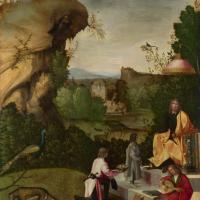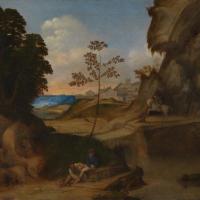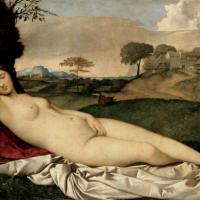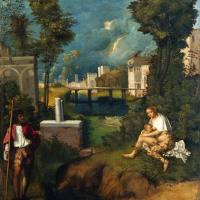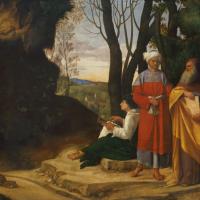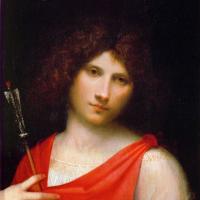Giorgione
Homage To A Poet
$480.00
Il Tramonto (The Sunset)
$480.00
Sleeping Venus
$480.00
The Tempest
$480.00
The Three Philosophers
$480.00
Young Man With Arrow
$480.00
Giorgione
Giorgione (1477-1510)
Giorgione (born Giorgio Barbarelli da Castelfranco; 1477/78–1510) was an Italian painter of the Venetian school during the High Renaissance from Venice, who died in his thirties. Giorgione is known for the elusive poetic quality of his work, though only about six surviving paintings are firmly attributed to him. The uncertainty surrounding the identity and meaning of his work has made Giorgione one of the most mysterious figures in European art.
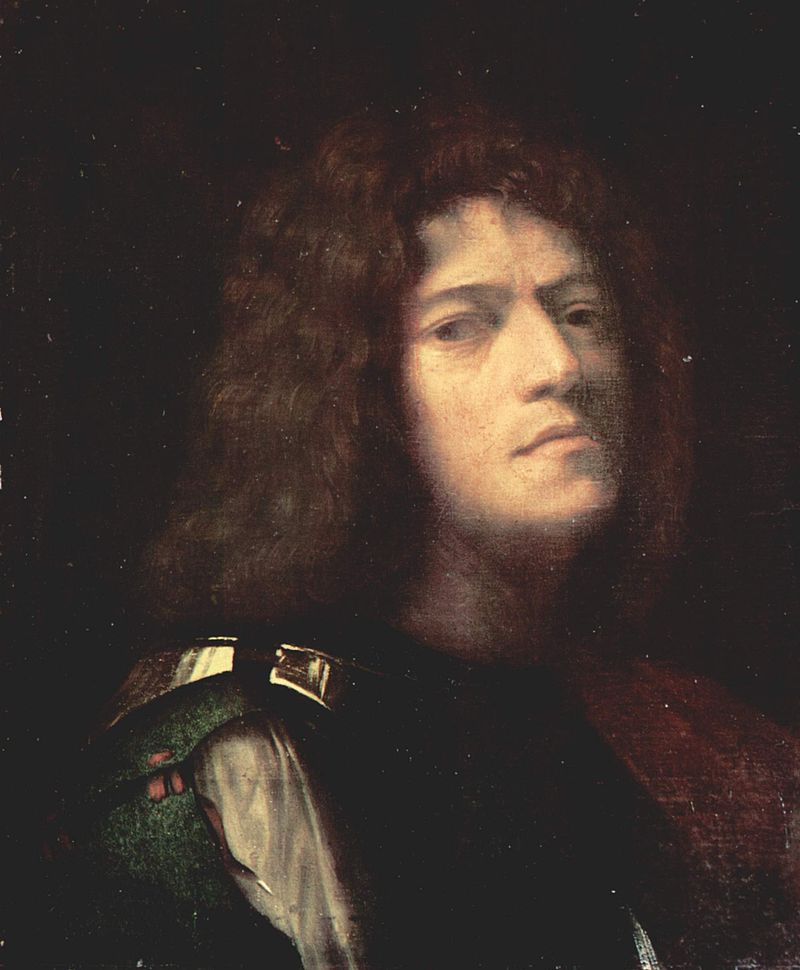
Together with Titian, who was probably slightly younger, he founded the distinctive Venetian school of Italian Renaissance painting, which achieves much of its effect through colour and mood, and is traditionally contrasted with Florentine painting, which relies on a more linear disegno-led style.
What little is known of Giorgione's life is given in Giorgio Vasari's Lives of the Most Excellent Painters, Sculptors, and Architects. The painter came from the small town of Castelfranco Veneto, 40 km inland from Venice. His name sometimes appears as Zorzo. The variant Giorgione (or Zorzon) may be translated "Big George". It is unclear how early in boyhood he went to Venice, but stylistic evidence supports the statement of Carlo Ridolfi that he served his apprenticeship there under Giovanni Bellini; there he settled and rose to prominence as a master.
Contemporary documents record that his gifts were recognized early. In 1500, when he was only twenty-three (if Vasari is correct about his age when he died), he was chosen to paint portraits of the Doge Agostino Barbarigo and the condottiere Consalvo Ferrante. In 1504, he was commissioned to paint an altarpiece in memory of another condottiere, Matteo Costanzo, in the cathedral of his native town, Castelfranco. In 1507, he received, at the order of the Council of Ten, partial payment for a picture (subject unknown) in which he was engaged for the Hall of the Audience in the Doge's Palace. From 1507 to 1508 he was employed, with other artists of his generation, to decorate with frescoes the exterior of the newly rebuilt Fondaco dei Tedeschi (or German Merchants' Hall) at Venice, having already done similar work on the exterior of the Casa Soranzo, the Casa Grimani alli Servi and other Venetian palaces. Very little of this work now survives.
Vasari mentions an important event in Giorgione's life, and one which influenced his work, his meeting with Leonardo da Vinci on the occasion of the Tuscan master's visit to Venice in 1500. All accounts agree in representing Giorgione as a person of distinguished and romantic charm, a great lover and a musician, given to express in his art the sensuous and imaginative grace, touched with poetic melancholy, of the Venetian existence of his time. They represent him further as having made in Venetian painting an advance analogous to that made in Tuscan painting by Leonardo more than twenty years before; that is, as having released the art from the last shackles of archaic rigidity and placed it in possession of full freedom and the full mastery of its means.
He was very closely associated with Titian; while Vasari says Giorgione was Titian's master, Ridolfi says that they both were pupils of Giovanni Bellini, and lived in his house. They worked together on the Fondaco dei Tedeschi frescoes, and Titian finished at least some paintings of Giorgione after his death, although which ones remains very controversial.
Giorgione also introduced a new range of subjects. Besides altarpieces and portraits he painted pictures that told no story, whether biblical or classical, or if they professed to tell a story, neglected the action and simply embodied in form and color moods of lyrical or romantic feeling, much as a musician might embody them in sounds. Innovating with the courage and felicity of genius, he had for a time an overwhelming influence on his contemporaries and immediate successors in the Venetian school, including Titian, Sebastiano del Piombo, Palma il Vecchio, il Cariani, Giulio Campagnola (and his brother), and even on his already eminent master, Giovanni Bellini. In the Venetian mainland, Giorgionismo strongly influenced Morto da Feltre, Domenico Capriolo, and Domenico Mancini.
Giorgione died of the plague then raging, on the 17th of September, 1510. He was usually thought to have died and been buried on the island of Poveglia in the Venetian lagoon, but an archival document published for the first time in 2011 places his death on the island of Lazzareto Nuovo; both were used as places of quarantine in times of plague. October 1510 is also the date of a letter by Isabella d'Este to a Venetian friend; asking him to buy a painting by Giorgione; the letter shows she was aware he was already dead. Significantly, the reply a month later said the painting was not to be had at any price.
His name and work continue to exercise a spell on posterity. But to identify and define, among the relics of his age and school, precisely what that work is, and to distinguish it from the similar work of other men whom his influence inspired, is a very difficult matter. Though there are no longer any supporters of the "Pan Giorgionismus" which a century ago claimed for Giorgione nearly every painting of the time that at all resembles his manner, there are still, as then, exclusive critics who reduce to half a dozen the list of extant pictures which they will admit to be actually by this painter.
Though he died at the age of 32 or 33, Giorgione left a lasting legacy to be developed by Titian and 17th-century artists. Giorgione never subordinated line and colour to architecture, nor an artistic effect to a sentimental presentation. He was arguably the first Italian to paint landscapes with figures as movable pictures in their own frames with no devotional, allegorical, or historical purpose—and the first whose colours possessed that ardent, glowing, and melting intensity which was so soon to typify the work of all the Venetian School.



